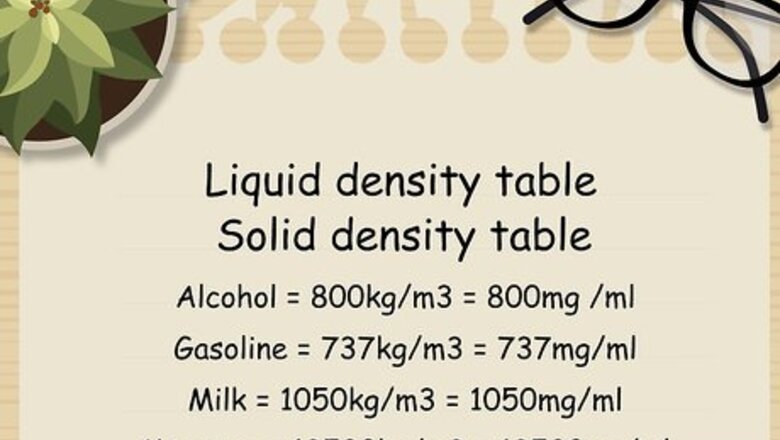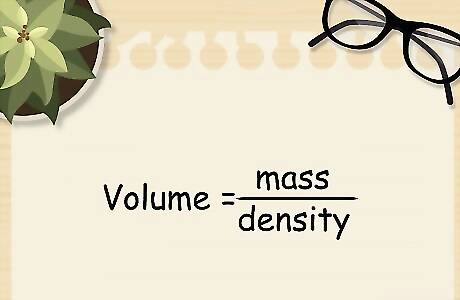
views
Converting Milligrams to Milliliters

Find the density of the material you are measuring. Because you are trying to convert mass into volume, you need to know the density of the material. Density is a measurement of how much mass fits in a given volume for any substance. Materials that we consider "heavy" have a high density, while "light" materials have a low density. Density tables exist online or in many text books for a wide range of substances. You can find a table of density values by searching for “density table,” “liquid density table,” or “solid density table.” The density of pure water is set at 1000 kg per cubic meter. This is the same as 1000 mg/ml. For comparison, some other common liquids have the following densities: Alcohol = 800 kg/m=800 mg/ml Gasoline = 737 kg/m=737 mg/ml Milk = 1050 kg/m=1050 mg/ml Mercury = 13590 kg/m=13590 mg/ml

Check with your pharmacist for medication densities. If you are trying to convert amounts for a prescription, you should check with your pharmacist. A pharmacist is in the best position to provide you with the correct density of whatever compound you need to measure. You may find the density of your substance printed on the bottle. You might check that before contacting the pharmacist.

Prepare to convert from mass to volume. Recall that density is equal to an item’s mass divided by its volume. Rearranging this formula. Volume = mass density {\displaystyle {\text{Volume}}={\frac {\text{mass}}{\text{density}}}} {\text{Volume}}={\frac {{\text{mass}}}{{\text{density}}}}.

Perform the conversion. When you know the density of the material and the measurement of the sample you wish to convert, perform the division to convert from mass to volume of your substance. For example, suppose you wish to convert 20,000 milligrams each of water, alcohol, gasoline, milk and mercury into milliliters. 20,000 milligrams is equal to 20 grams, which is about the weight of 20 paper clips. The conversions for these five liquids are as follows: Water: ( 20 , 000 mg ) / ( 1000 mg/ml ) = 20 ml water {\displaystyle (20,000{\text{ mg}})/(1000{\text{ mg/ml}})=20{\text{ ml water}}} (20,000{\text{ mg}})/(1000{\text{ mg/ml}})=20{\text{ ml water}} Alcohol: ( 20 , 000 mg ) / ( 800 mg/ml ) = 25 ml alcohol {\displaystyle (20,000{\text{ mg}})/(800{\text{ mg/ml}})=25{\text{ ml alcohol}}} (20,000{\text{ mg}})/(800{\text{ mg/ml}})=25{\text{ ml alcohol}} Gasoline: ( 20 , 000 mg ) / ( 737 mg/ml ) = 27.137 ml gasoline {\displaystyle (20,000{\text{ mg}})/(737{\text{ mg/ml}})=27.137{\text{ ml gasoline}}} (20,000{\text{ mg}})/(737{\text{ mg/ml}})=27.137{\text{ ml gasoline}} Milk: ( 20 , 000 mg ) / ( 1050 mg/ml ) = 19.048 ml milk {\displaystyle (20,000{\text{ mg}})/(1050{\text{ mg/ml}})=19.048{\text{ ml milk}}} (20,000{\text{ mg}})/(1050{\text{ mg/ml}})=19.048{\text{ ml milk}} Mercury: ( 20 , 000 mg ) / ( 13590 mg/ml ) = 1.4717 ml mercury {\displaystyle (20,000{\text{ mg}})/(13590{\text{ mg/ml}})=1.4717{\text{ ml mercury}}} (20,000{\text{ mg}})/(13590{\text{ mg/ml}})=1.4717{\text{ ml mercury}}
Converting Milliliters to Teaspoons

Learn the conversion factor. Because milliliters and teaspoons are both measurements of volume, the density of the different materials no longer makes a difference. Converting from milliliters to teaspoons is fairly easy because the conversion factor is just 5 to 1. That is, 5 ml = 1 tsp. If you know a measurement in milliliters, you can convert to teaspoons by just dividing by 5.

Perform the conversion. Using the five samples from above, prepare for the conversion to teaspoons. Water: 20,000 mg = 20 ml/5 = 4 teaspoons Alcohol: 20,000 mg = 25 ml/5 = 5 teaspoons Gasoline: 20,000 mg = 27.137 ml/5 = 5.4274 teaspoons Milk: 20,000 mg = 19.048 ml/5 = 3.8096 teaspoons Mercury: 20,000 mg = 1.4717 ml/5 = 0.29434 teaspoons

Review the results. Pure water is set as the standard for conversion density, with a density of 1.0 grams per milliliter. The densities of all other substances are set in relation to the density of water. Notice that mercury, with an extremely high density, converts to only about a quarter teaspoon for the same mass of water that equals one teaspoon.




















Comments
0 comment